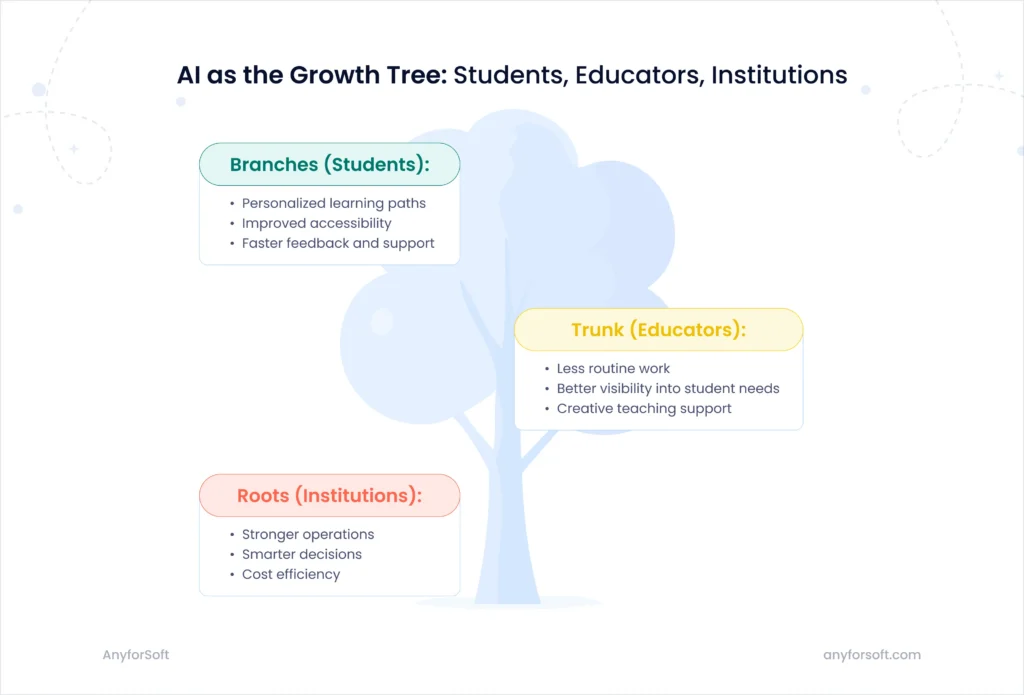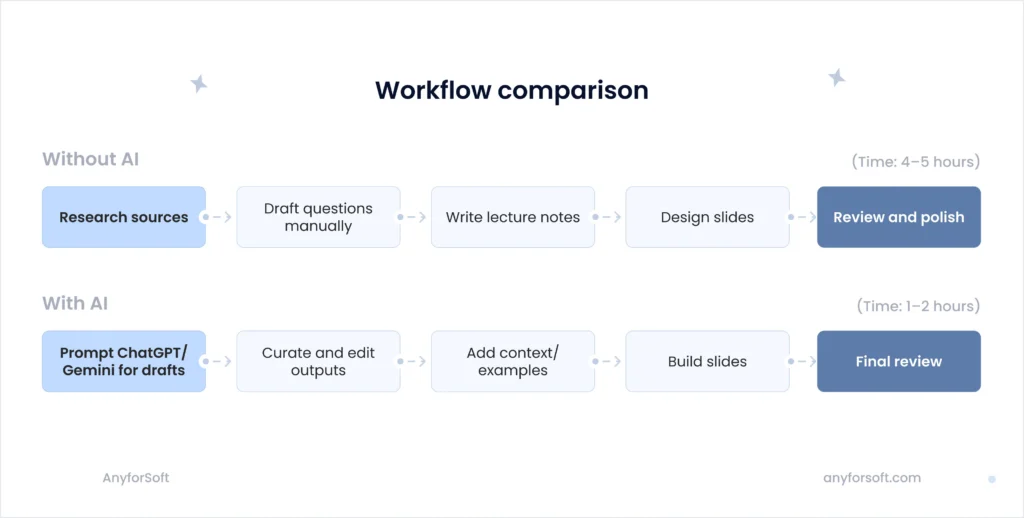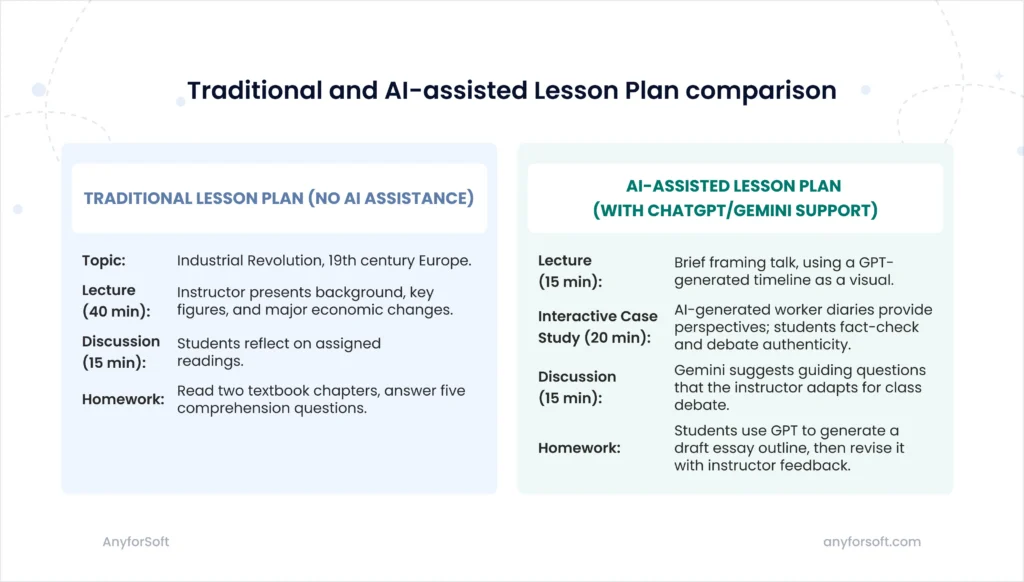The Role of AI in Higher Education
AI is reshaping industries worldwide, but higher education is not keeping pace. While enterprise AI adoption climbed from 55% of organizations in 2023 to 78% in 2024, fewer than 10% of universities have formal AI policies.
What is the reason for such hesitation? The 2025 EDUCAUSE AI Landscape Study shows that only 2% of institutions invest gladly in Artificial Intelligence in higher education. The rest still underestimate the real costs of implementation. In addition, just 9% of universities believe their cybersecurity and privacy frameworks are ready for AI-specific risks.
This conservatism makes sense: multiple legacy systems, compliance-heavy environments, and cautious governance slow down experimentation. Yet, let’s look at the potential upside.
AI improves student outcomes and eases administrative burden. The benefits outweigh the risks — especially when supported by a development partner who prioritizes data security, compliance, and cost efficiency.
AnyforSoft brings exactly this expertise, with a proven track record of building and modernizing platforms for institutions like Wittenborg University of Applied Sciences and Imperial College Business School.
If you’re a higher education leader and lack the information needed for confident decision-making, this article is here to help.
We’ll highlight real use cases of AI in higher education, outline the advantages, and show you how to overcome potential hurdles along the way.
Benefits of AI in Higher Education
Think of AI in higher education as visible growth, illustrated with a tree metaphor.
Institutions gain stronger roots, educators become better supported, and students flourish when learning adjusts to them.

For leaders, the relationship between AI and higher education is not abstract. It’s about practical tools that support students, faculty, and institutions in measurable ways.
Benefits for students
For students, AI creates learning experiences that feel personal. Instead of a one-size-fits-all path, learners can progress at the pace that matches their abilities and confidence.
Accessibility is another powerful capability. Automatic transcription, real-time translation, and text-to-speech tools reduce barriers that used to shut students out of opportunities.
For a student who doesn’t speak the local language fluently or has hearing difficulties, AI-based assistance can mean the difference between frustration and success.
AI also provides clarity and reassurance. Instead of waiting days for feedback or support, students can access guidance instantly. Even when it’s a basic check on deadlines or requirements, the quick response keeps momentum and reduces the risk of dropping out.
Benefits for educators
For educators, AI takes over the kind of work that drains energy but adds little value.
AI automates grading for standard tests, plagiarism checks, and routine assignments. That frees up time for mentorship, class discussions, one-on-one guidance, and deeper feedback on student work.
But efficiency is only one of many benefits.
AI gives teachers visibility they’ve never had before, such as:
- Spotting patterns in student performance.
- Highlighting who needs extra support.
- Detecting early signs of disengagement.
In practice, it feels like having an early-warning system for student struggles.
AI also lends creative support. Lesson planning becomes faster when tools suggest structures or generate examples that can be tailored. The teacher still makes the final call, but instead of starting from scratch every time, they have a head start.
Ronald Brooks Jr., Associate Professor of Writing Studies at Montclair State University, emphasizes how generative AI is transforming teaching practices and forcing educators to rethink both course design and pedagogy:
“It will completely redefine how we teach writing, and for many of us, redefine how we teach.”
Source: montclair.edu.
Only when routine burdens are lifted can educators focus on the uniquely human side of teaching: motivation, empathy, and inspiration.
Benefits for institutions
At the institutional level, AI solutions in education improve operations and decision-making.
AI streamlines administrative workflows, such as admissions or scheduling. This way, it reduces delays that frustrate both staff and applicants.
For leaders trying to manage limited resources, that efficiency translates into real cost savings.
Beyond daily tasks, AI supports long-term strategy. Predictive analytics help leaders see enrollment trends, monitor program performance, and allocate budgets with greater confidence.
Instead of reacting to problems, institutions can prepare in advance and shape outcomes.
There’s also a reputational advantage. Students and families increasingly expect universities to adopt modern tools. When institutions use AI responsibly, balancing efficiency with privacy and compliance, they strengthen their brand as forward-looking and trustworthy.
Real-World Use Cases of AI for Higher Education
Adoption of AI in higher ed is still slower than in many other industries, yet the pace is picking up.
According to EDUCAUSE, 57% of colleges in late 2024 now consider AI a strategic priority (up from 49% the year before). Moreover, more than half are already experimenting with applications in curriculum design (54%) or administrative automation (52%).
This signals a shift: colleges and universities are beginning to see AI as both feasible and effective.
The following examples show how AI in college education is already being applied. Consider these examples as early signals of how artificial intelligence and higher education can align to improve student success and campus operations.
AI-powered learning platforms
The main idea of the initiative at the University of Central Florida (USA) was straightforward: let the course adjust to the student.
It was first applied in big entry-level classes like math and chemistry through an adaptive system of course management that tuned content and pace to each learner.
The impact was twofold:
- Students got a more personalized path, which means extra support when they struggled and faster progress when they were ready to move ahead.
- The faculty discovered new ways to collaborate, redesign courses, and keep improving them semester after semester.
This case illustrates how a single innovation can spread across an academic institution by enhancing student success while also improving the effectiveness of other teaching tools.
The bigger takeaway here is as follows: using AI in more than one area doesn’t just add benefits. It creates synergy, where each tool amplifies the others.
Chatbots for student support
Georgia State University (USA) set up “Pounce,” a chatbot that texts students and answers their routine questions. It answers questions on essential topics like deadlines, financial aid, and access to campus resources.
A chatbot cuts down the need to chase staff for answers by responding instantly and with relevant context.
In testing, Pounce handled over 50,000 exchanges and helped reduce “summer melt,” keeping more admitted students actually on track to show up in the fall.
Assistant VP Scott Burke: “After the trial’s success the university not only kept Pounce in use but also expanded its role to support new initiatives in enrollment and student success.”
AI in admissions and enrollment
In the United States, many colleges and universities are already experimenting with AI to make admissions faster and more consistent.
A 2023 Intelligent survey found that one in two admissions offices already used AI in application reviews. The use cases include machine learning systems that scan transcripts and recommendation letters. Another example is chatbots that answer applicant questions or even run short initial interviews.
Conversations with admissions teams reveal why this shift matters. Staff spend up to 40% of their workday on manual follow-ups, chasing missing documents, confirming file completeness, and handling repetitive email floods.
AI can automate much of the routine in many ways, for example, by:
- Triggering reminders.
- Flagging incomplete applications.
- Running authenticity checks.
And all these tasks are done before a human ever opens the file.
Such automation reduces delays, lowers error rates, and frees admissions officers to focus on shaping cohorts and making judgment calls.
In this approach, people, not algorithms, add real value.
Accelerating academic research
At the Massachusetts Institute of Technology (USA), the FutureHouse lab is building AI “co-pilots” for scientists. These agents can search and summarize literature, suggest chemical syntheses, and run data analysis. This way, researchers don’t spend most of their time on routine work.
The strength of FutureHouse lies in its custom agents, designed for scientific workflows, rather than generic AI accessed through an API.
FutureHouse co-founder Sam Rodriques: “People who are looking for speculation tend to get more mileage out of Chat-GPT deep research, while people who are looking for really faithful literature reviews tend to get more out of our agents.”
The real difference is that off-the-shelf AI can inspire, but tailored solutions built for specific tasks deliver consistency, reliability, and measurable impact.
Challenges and Ethical Considerations
Artificial intelligence in higher education offers real potential, but it also raises challenges that can’t be overlooked. These challenges sit at the intersection of ethics, compliance, and culture, making them harder to solve than just technical problems. For university leaders, it’s not about diminishing the role of AI for higher ed. The main task is to ensure the responsible adoption, in ways that protect both students and staff.
Data privacy and student surveillance
One of the most pressing worries is how AI systems handle student information. From exam proctoring to learning analytics, the data collected can feel intrusive, even when the goal is personalization or security. UNESCO’s 2023 guidance warned that most countries lack regulations for generative AI, leaving privacy gaps. This puts universities in a vulnerable position in terms of AI data privacy.
How to overcome:
- Build transparency into data practices and explain to students how their data is used.
- Apply role-based access so only authorized personnel can view sensitive files.
- Select systems designed for compliance first. AnyforSoft has delivered GDPR-compliant platforms for European universities, proving that secure solutions are realistic and workable.
Academic integrity and AI-generated content
Generative AI makes it easier for students to bypass honest work, and institutions are already noticing the strain. Three in four campus CTOs say that AI has become a moderate or significant risk to academic integrity at their schools (InsideHigherEd, 2024). Faculty now face more plagiarism attempts, harder-to-detect essays, and rising pressure to adjust assessments.
How to overcome:
- Rethink assignments so they require critical thinking instead of surface-level answers.
- Pair AI detection with AI literacy training, showing students when and how tools can be used responsibly.
- Use compliance-focused tools like AnyforSoft’s FilterSync, which help universities manage AI risks in content and preserve standards.
Algorithmic bias and equity issues
AI is only as fair as the data it learns from, and that’s the core problem. In practice, bias can sneak into admissions tools, advising systems, or even grading platforms. Research from Times Higher Education highlights another layer: students from wealthier backgrounds are far more likely to use AI for their studies than peers with fewer resources, creating a digital divide.
How to overcome:
- Test AI models for bias before and during use, not just once.
- Guarantee broader access to AI tools so all students benefit equally.
- Design systems with inclusivity in mind. AnyforSoft specializes in multilingual, accessible platforms that support diverse student populations.
Faculty resistance and training gaps
Even as AI tools spread, many instructors feel unprepared or cautious. An Ithaka S+R survey of 2,600 faculty in 2024 found that only 14% were confident in using AI in teaching, and just 18% understood its pedagogical implications. For a field built on expertise, that lack of readiness fuels resistance. Some faculty simply block AI use in class altogether, which solves little.
How to overcome:
- Offer regular AI training and hands-on workshops for faculty.
- Launch pilot programs that let instructors test tools in a safe, supported way.
- Provide ongoing support. AnyforSoft has helped schools like Wittenborg University and MEGU pair system deployment with staff training, ensuring smoother adoption.
Generative AI and the Future of Teaching
It’s 2029, and the university classroom doesn’t look all that different. It’s still rows of desks, a whiteboard, the same hum of pre-lecture chatter. But under the surface, artificial intelligence and higher education together have changed almost everything.
Lesson prompts flash onto the screen, drafted overnight by an AI co-pilot. Students pull up personalized study notes on their tablets, tuned to their pace and strengths. The professor still leads, questions still spark debate, but the hidden partner in the room is generative AI in higher ed. It is working quietly in the background.
How tools like ChatGPT and Gemini are used
Picture a literature professor preparing tomorrow’s seminar. Without AI, the evening stretches into hours of hunting through journals and polishing slides until midnight. Every question, every quiz item, every example must be built from scratch. It works, but it leaves little space for creativity, and even less for rest.
Now rewind the scene with an AI co-pilot in play.
The professor opens ChatGPT and Gemini, asks for prompts, quiz questions, and a short article summary. Minutes later, there’s a workable draft. It’s not perfect, but easy to refine. Instead of wrestling with a blank page, the professor curates and adds context, saving energy for what matters most: teaching in the room.
How to make it work:
- Use AI for first drafts and brainstorming, not final judgment.
- Keep faculty curation at the center to ensure accuracy and relevance.
- Be transparent with students about when and how AI is used in class prep.

Lesson planning and content co-creation
Creating lessons to teach students effectively has always required a mix of structure and creativity. Without AI, the work often starts with a blank page: mapping topics, writing lecture notes, adding reading lists, and hoping students stay engaged. It’s effective, but heavy.
When AI in Edtech enters the loop, that same process looks different. It shifts from a solo effort to more of a collaboration.
Here’s how a history class on the Industrial Revolution might look:

The difference is not that one plan is right and the other wrong. It’s that the AI-assisted version injects variety, cuts prep time, and shifts focus from lecture delivery to student engagement. The professor still owns the lesson, but AI fills in the scaffolding, so teaching energy goes to what’s uniquely human.
How to make it work:
- Treat AI outputs as drafts to edit, not finished products.
- Use AI for creative sparks (e.g., case studies, guiding questions).
- Build in activities in which students critique or refine AI content. It’s a way of turning a potential risk into a learning tool.
Faculty upskilling and readiness
In the near-future classroom, the real change comes not from the tools but from the professor. Generative AI shifts faculty from content deliverers to guides and mentors, a role that comes with a steep learning curve.
Upskilling takes more than a one-off workshop. Around the world, some universities are already experimenting with different ways to prepare faculty for this shift.
How Universities Prepare Faculty for Generative AI
| Institution | How AI is used to train faculty | Expected outcomes |
| Babson College (USA) | Faculty-led Generator Lab. Hands-on experimentation, interdisciplinary groups (ethics, arts, business, prototyping), peer training | Peer training (50% of faculty reached); curriculum development (new MBA and undergraduate courses); community building (cross-disciplinary innovation). |
| University of Georgia (USA) | Generative AI & Teaching Faculty Fellows (GAIT) program.15 fellows annually, workshops, one-on-one support, pilots of AI-supported teaching innovations. | Faculty development (AI teaching strategies); knowledge sharing (annual colloquium); campus-wide diffusion (innovation spreading beyond the cohort). |
| University of Nevada, (USA) | Generative AI Fellows Pilot Program. Uses a “train-the-trainer” model, where selected fellows learn AI methods and then share knowledge with colleagues across campus. | Faculty integration (AI in teaching); research enhancement (AI in analysis and grant writing); workflow optimization (administrative efficiency). |
How to make it work:
- Offer continuous training, not one-time sessions.
- Create safe spaces (labs or studios) where faculty can test AI without pressure.
- Recognize and reward instructors who experiment responsibly, turning early adopters into role models for the rest.
At AnyforSoft, we translate these practices into the education space:
- Building secure platforms for colleges like Delaware County Community College, with encryption protocols, role-based access, and compliance-ready data handling.
- Managing complex system integrations for institutions such as Projektmagazin, where we migrated 13,000+ content nodes and connected multiple systems while ensuring uptime and scalability.
- Redeveloping a custom LMS with mobile-first design, interactive content support, and advanced admin tools — improvements that drove higher student engagement and completion rates.
These experiences align with the same priorities universities face when adopting AI, such as data privacy, system reliability, and faculty empowerment.
Conclusion
AI in higher education has moved beyond theory. The examples show how AI-powered solutions can enhance learning and ease faculty workloads. Each case points to the same pattern: when universities integrate AI thoughtfully, the benefits extend across teaching, research, administration, and student experience.
A successful AI implementation strategy reveals value on several levels:
- Students progress with learning paths that match their pace and abilities.
- Faculty reclaim time for mentoring, research, and creative instruction.
- Institutions gain clarity for planning, resource allocation, and long-term strategy.
- Reputation grows when innovation is paired with responsibility.
The strongest message here is forward-looking: higher education does not lose its identity by adopting AI. It expands its capacity to fulfill its mission.The question for leaders is no longer whether AI belongs on campus. It is where it can bring the most impact first, and how quickly that impact can be multiplied. The next step is to explore those outcomes in the context of your own institution and chart a path that balances ambition with care.
FAQs
AI adapts to how students learn, offering extra practice when they struggle and faster progression when they’re ready. This approach, made possible through advances in education software development, also gives timely feedback, which reduces frustration and keeps momentum steady. For many students, that consistency is what helps them stay engaged.
No, and most educators would agree it shouldn’t. AI can remind, flag, and organize, but it doesn’t replace mentorship or judgment. Students still look for guidance, encouragement, and perspective, which only people can provide.
The best way is to start with small steps:
- Let AI handle draft quiz questions or suggest discussion prompts.
- Refine outputs with personal insight and academic judgment.
- Be clear with students about when and why AI is used.
That openness helps build trust and turns AI into a learning partner rather than a shortcut.
Students today encounter a wide range of AI tools integrated through higher education website development, each helping in a slightly different way.
Some of the most practical include:
- Adaptive learning platforms that tune lessons to individual progress. They give more practice when needed and speed up when mastery shows.
- Chatbots that answer routine questions on deadlines, financial aid, or campus resources. As a result, tudents aren’t left waiting for replies.
- Smart campus applications that provide real-time updates on facilities, class schedules, or even virtual tours. Such tools help students feel more connected and informed.
- Writing assistants for drafting, editing, and structuring essays or reports. Their goal is to save time; the tools still require student judgment.
- Accessibility tools such as transcription, translation, or text-to-speech. These tools open the door for students who face language or disability barriers.
- Generative AI study helpers that can create draft outlines, flashcards, or summaries of reading material. They are useful as a starting point but not a replacement for deep learning.
- Research support tools — some universities now offer AI “co-pilots” that help students scan literature, organize findings, and explore complex topics more quickly.
Together, listed tools make studying less about chasing logistics and more about focusing on understanding.








